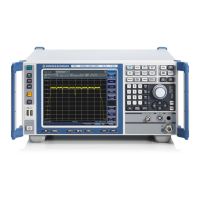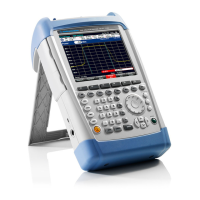Quick Start
R&S
®
FSVA/FSV
94Operating Manual 1176.7510.02 ─ 09
Prerequisites for using the internal frequency counter
In order to obtain a correct result when measuring the frequency with the internal fre-
quency counter, an RF sinusoidal signal or a spectral line must be available. The
marker must be located more than 25 dB above the noise level to ensure that the
specified measurement accuracy is adhered to.
2.5.2 Measuring Harmonics of Sinusoidal Signals
Measuring the harmonics of a signal is a very common task that can be performed
optimally by using a Signal and Spectrum Analyzer.
In the following example, the generator signal with 128 MHz and -20 dBm is used
again.
Measuring the Suppression of the First and Second Harmonic of an Input Signal
1. Set the signal analyzer to the default state by pressing the PRESET key.
The R&S FSVA/FSV is in the default state.
2. Set the start frequency to 100 MHz and the stop frequency to 400 MHz.
a) Press the FREQ key.
b) Press the "Start" softkey and enter 100 MHz.
c) Press the "Stop" softkey and enter 400 MHz.
The R&S FSVA/FSV displays the fundamental and the first and second har-
monics of the input signal.
3. To average (smooth) the noise, reduce the video bandwidth.
a) Press the BW key.
b) Press the "Video BW Manual" softkey and enter 100 kHz.
4. Set the attenuation to 0 dB.
a) Press the AMPT key.
b) Press the "RF Atten Manual" softkey.
c) Enter 0 dB in the edit dialog box.
5. Activate the marker by pressing the MKR key.
"Marker 1" is activated and positioned to the signal maximum (fundamental at 128
MHz). The level and frequency of the marker is displayed in the marker field.
6. Activate the delta marker and measure the harmonic suppression.
a) In the "MKR" menu, press the "Marker 2" softkey.
"Marker 2" is activated as a delta marker ("D2 [1]"). It is automatically set on
the largest harmonic of the signal. The frequency offset and level offset from
marker 1 are displayed in the channel information bar.
Basic Measurement Examples

